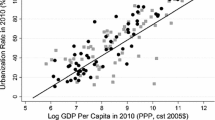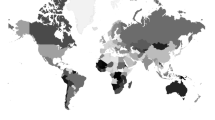Abstract
Australia’s several major mining booms since the 1840s have impacted positively on national economic growth and non-trivially on the competitiveness of other sectors of its economy. This paper shows the latter to be consistent with economic theory only when sectoral policy developments are taken into consideration. It reveals several features that make the sectoral composition of Australia’s economy unusual. One is that the manufacturing share of GDP was unusually high until protectionism was phased out from the 1970s. Another is that the farm sector continued to enjoy a strong comparative advantage despite mining booms and high rates of assistance to import-competing manufacturers. Also, the agricultural and services sectors’ shares of GDP remained fairly constant rather than diverging during 1860–1960. The paper concludes by drawing out implications for future policies.








Similar content being viewed by others
Notes
National income is less likely to rise the poorer the government’s macroeconomic management and the more distorting are its sectoral and trade policies. Adverse outcomes are so common among developing countries as to have given rise to the term “resource curse” (coined by Auty 1993). Extensive reviews of that literature can be found in van der Ploeg (2011), Smith (2015), and Venables (2016).
It leaves aside the question of how these structural changes and shocks contributed to the growth and fluctuations in the country’s aggregate output, employment, and income. The reasons for high per capita income in Australia in the nineteenth century and continued prosperity to date is the subject of a study by McLean (2013). Evidently Australia managed to avoid the “resource curse.”
Gold (not shown) contributed more than meat to New Zealand’s exports prior to the 1880s. Argentina’s exports also were highly concentrated on two products: wool and hides to the 1880s and wool and grain from then to World War I.
References
ABARES (2015) Agricultural commodities statistics 2015. Australian Bureau of Agricultural and Resource Economics and Sciences, Canberra
ABS (2017) Labour force, Australia Cat No 6291.0. Australian Bureau of Statistics, Canberra
Alston JM, Pardey PG (2016) Antipodean agricultural and resource economics at 60: agricultural innovation. Aust J Agric Resour Econ 60(4):554–568. https://doi.org/10.1111/1467-8489.12162
Anderson K (1987a) On why agriculture declines with economic growth. Agric Econ 1(3):195–207. https://doi.org/10.1016/0169-5150(87)90001-6
Anderson K (1987b) Tariffs and the manufacturing sector. In: Maddock R, McLean I (eds) The Australian Economy in the Long Run. Cambridge University Press, Cambridge, pp 165–195
Anderson K (2009) Distortions to agricultural incentives: a global perspective, 1955–2005. Palgrave Macmillan and World Bank, London and Washington DC
Anderson K (with the assistance of N.R. Aryal) (2015). Growth and cycles in Australia’s wine industry: a statistical compendium, 1843 to 2013. (Adelaide: University of Adelaide Press). [Accessed 17 Oct 2016]. Available from URL: www.adelaide.edu.au/press/titles/austwine and as Excel spreadsheets at www.adelaide.edu.au/wine-econ/databases/winehistory
Anderson K, Garnaut R (1987) Australian protectionism: extent, causes and effects. Allen and Unwin, Sydney
Anderson K, Smith B (1981) Changing economic relations between Asian ADCs and resource-exporting developed countries. In: Hong W, Krause L (eds) Trade and growth in the advanced developing countries. Korea Development Institute Press, Seoul, pp 293–338
Anderson K, Strutt A (2014) Emerging economies, productivity growth, and trade with resource-rich economies by 2030. Aust J Agric Resour Econ 58(4):590–606. https://doi.org/10.1111/1467-8489.12039
Anderson K, Lloyd P, MacLaren D (2007) Distortions to agricultural incentives in Australia since World War II. Econ Record 83(263):461–482
Anderson K, Lattimore R, Lloyd P, MacLaren D (2009) Australia and New Zealand. In: Anderson K (ed) Distortions to agricultural incentives: a global perspective, 1955–2005. Palgrave Macmillan and World Bank, Londonand Washington DC, pp 221–256
Auty RM (1993) Sustaining development in mineral economies: the resource curse thesis. Routledge, London. https://doi.org/10.4324/9780203422595
Blainey G (1966) The tyranny of distance: how distance shaped Australia’s history. Macmillan, Melbourne
Blainey G (2003) The rush that never ended: a history of Australian mining, 5th edn. Melbourne University Press, Melbourne
Brigden JR, Copeland DB, Dyason EC, Giblin LF, Wickens CH (1929) The Australian tariff: an economic enquiry. Melbourne University Press, Melbourne
Butlin NG, Sinclair WA (1986) Australian gross domestic product 1788–1860: sources and methods. Aust Econ Hist Rev 26(2):127–147
Butlin M, Dixon R, Lloyd PJ (2014) A statistical narrative: Australia, 1800–2010. In: Ville S, Withers G (eds) The Cambridge economic history of Australia. Cambridge University Press, Cambridge, pp 555–594
Corden WM (1984) Booming sector and Dutch disease economics: survey and consolidation. Oxf Econ Pap 36(3):359–380. https://doi.org/10.1093/oxfordjournals.oep.a041643
Davidson BR (1981) European farming in Australia: an economic history of Australian farming. Elsevier, Amsterdam
Deardorff AV (1984) An exposition and exploration of Krueger’s trade model. Can J Econ 5(4):731–746
Federico G (2005) Feeding the world: an economic history of agriculture, 1800–2000. Princeton University Press, Princeton
Findlay R (1995) Factor proportions, trade, and growth. MIT Press, Cambridge
Freebairn J (2015) Mining booms and the exchange rate. Aust J Agric Resour Econ 59(4):533–548. https://doi.org/10.1111/1467-8489.12046
Gillitzer C, Kearns J (2005) Long-term patterns in Australia’s terms of trade. RDP2005-01. Reserve Bank of Australia, Sydney
Grafton RQ, Mullen J, Williams J (2015) Australia’s agricultural future: returns, resources and risks. Australian Council of Learned Academies, Melbourne
Griffith G, Watson AS (2016) Antipodean agricultural and resource economics at 60: agricultural markets and marketing policies. Aust J Agric Resour Econ 60(4):594–609. https://doi.org/10.1111/1467-8489.12161
Hatton T, Withers G (2014) The labour market. In: Ville S, Withers G (eds) The Cambridge economic history of Australia. Cambridge University Press, Cambridge, pp 351–372
Jones RW (1971) A three-factor model in theory, trade, and history. Ch. 1. In: Bhagwati JN, Jones R, Mundell R, Vanek J (eds) Trade, balance of payments and growth. North-Holland, Amsterdam
Jones RW (1975) Income distribution and effective protection in a multicommodity trade model. J Econ Theory 11(1):1–15. https://doi.org/10.1016/0022-0531(75)90035-6
Krueger AO (1977) Growth, distortions and patterns of trade among many countries. International Finance Section, Princeton
Kuznets S (1966) Modern economic growth: rate, structure and spread. Yale University Press, New Haven
Leamer EE (1987) Paths of development in the three-factor, n-good general equilibrium model. J Polit Econ 95(5):961–999. https://doi.org/10.1086/261498
Lee D (2013) Reluctant relaxation: the end of the iron ore export embargo and the origins of Australia’s mining boom, 1960–1966. History Australia 10(3):149–170
Lerner A (1936) The symmetry between import and export taxes. Economica 3(11):306–313. https://doi.org/10.2307/2549223
Lloyd PJ (2017) The first hundred years of tariffs in Australia: the colonies. Aust Econ Hist Rev 57(3):316–344. https://doi.org/10.1111/aehr.12104
Lloyd PJ, MacLaren D (2015) Relative assistance to Australian agriculture and manufacturing since Federation. Aust J Agric Resour Econ 59(2):159–170. https://doi.org/10.1111/1467-8489.12070
Maddock R, McLean I (1984) Supply-side shocks: the case of Australian gold. J Econ Hist 44(4):1047–1067. https://doi.org/10.1017/S0022050700033088
McLean IW (2013) Why Australia prospered: the shifting sources of economic growth. Princeton University Press, Princeton
Mitchell BR (2005) International historical statistics. Palgrave Macmillan, Basingstoke
Norgés J (2011) Agro e Industria: del centenario al bicentenario. [Agriculture and industry: from the centenary to the bicentenary]. Ciudad Argentina, Buenos Aires
Productivity Commission (2003) From industry assistance to productivity: 30 years of ‘the commission’. Productivity Commission, Canberra
RBA (2017) Commodity prices (Sydney: Reserve Bank of Australia). Accessed 21 July at http://www.rba.gov.au/statistics/frequency/commodity-prices/2017
Samuelson PA (1981) Summing up on the Australian case for protection. Q J Econ 96(1):147–160. https://doi.org/10.2307/2936145
Shaw A (1990) Colonial settlement 1788–1945. In: Williams DB (ed) Agriculture in the Australian economy, 3rd edn. University of Sydney Press, Sydney, pp 1–18
Sinclair, W.A. (2009) Annual estimates of gross domestic product: Australian colonies/states 1861–1976/77. [Accessed 17 Oct 2016]. Available at URL: http://arrow.monash.edu.au/hdl/1959.1/88855
Smith B (2015) The resource curse exorcised: evidence from a panel of countries. J Dev Econ 116(1):57–73. https://doi.org/10.1016/j.jdeveco.2015.04.001
Stolper W, Samuelson PA (1941) Protection and real wages. Rev Econ Stud 9(1):58–73. https://doi.org/10.2307/2967638
Sturzenegger AC, Salazni M (2008) Argentina. In: Anderson K, Valdéz A (eds) Distortions to agricultural incentives in Latin America. World Bank, Washington DC, pp 59–85
Syrquin M (1988) Patterns of structural change. In: Chenery H, Srinivasan TN (eds) Handbook of Development Economics, Vol 1. North-Holland, Amsterdam, pp 203–273
Syrquin M, Chenery H (1989) Three decades of industrialization. World Bank Econ Rev 3(1):145–181. https://doi.org/10.1093/wber/3.2.145
Trebilcock MJ (2014) Dealing with losers: the political economy of policy transitions. Oxford University Press, London. https://doi.org/10.1093/acprof:oso/9780199370658.001.0001
van der Ploeg F (2011) Natural resources: curse or blessing? J Econ Lit 49(2):366–420. https://doi.org/10.1257/jel.49.2.366
Vanplew W (1987) Australians: historical statistics. Fairfax, Syme and Weldon, Sydney
Venables AJ (2004) Small, remote and poor. World Trade Rev 3(3):453–457. https://doi.org/10.1017/S147474560400206X
Venables AJ (2016) Using natural resources for development: why has it proven so difficult? J Econ Perspect 30(1):161–184. https://doi.org/10.1257/jep.30.1.161
Viner J (1929) The Australian tariff. Economic Record 5(9):306–315. https://doi.org/10.1111/j.1475-4932.1929.tb00624.x
World Bank (2017) World development indicators. Accessed 20 July at http://wdi.worldbank.org/
WTO (2016) International trade statistics 2016. World Trade Organization, Geneva
Author information
Authors and Affiliations
Corresponding author
Additional information
Thanks are due to referees for comments on an earlier draft. (Kym Anderson)
Rights and permissions
About this article
Cite this article
Anderson, K. Mining’s impact on the competitiveness of other sectors in a resource-rich economy: Australia since the 1840s. Miner Econ 31, 141–151 (2018). https://doi.org/10.1007/s13563-017-0133-8
Received:
Accepted:
Published:
Issue Date:
DOI: https://doi.org/10.1007/s13563-017-0133-8




